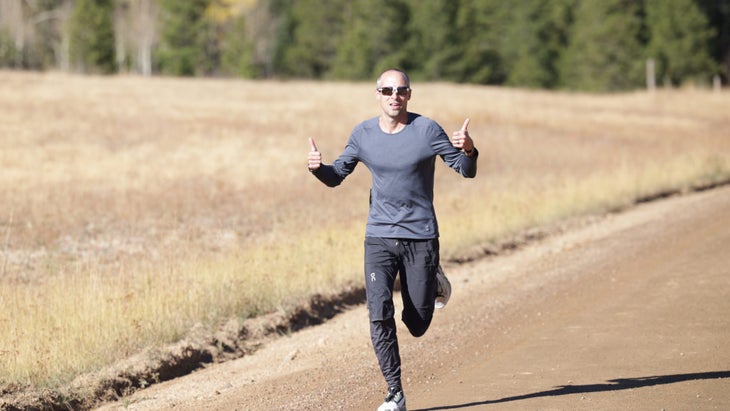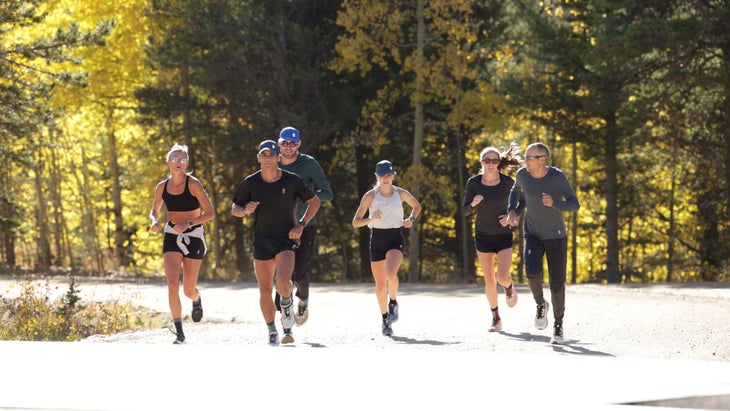Products You May Like
Get access to everything we publish when you
sign up for Outside+.
It’s hard to believe that On Athletics Club (OAC), the running team sponsored by the Swiss shoe company known for its distinctive outsole bubbles, was launched less than two years ago. Made up of nine athletes, most of whom have only recently begun their professional careers, the group has already produced five Olympians and five national records, rapidly becoming a dominating force in elite running.
On January 29, three of its athletes put down triumphant performances at the prestigious Millrose Games in New York City: Alicia Monson won the women’s 3K, George Beamish the men’s 3K, and Oliver Hoare the Wanamaker Mile.
The man engineering the OAC machine is Dathan Ritzenhein, a three-time Olympian and former 5,000-meter American record holder. In 2020, Ritzenhein announced that he was officially retiring from professional running and was soon named head of the new On Athletics Club, based in Boulder, Colorado. Ritzenhein previously served as a volunteer assistant coach at the University of Oregon and at Grand Valley State University, in Michigan, from 2014 to 2017 and later coached a small, sub-elite group in Grand Rapids, Michigan, but the On Athletics Club is his first plunge into coaching a world-class team.
We spoke with Ritzenhein about how he’s coached his relatively young team to rapid success, the tenets of his coaching philosophy, and one of his staple workouts for mid-distance and long-distance runners. Here’s some of his best advice.
RELATED: Hellen Obiri Moving from Kenya to Colorado for OAC

Build Consistency into Your Training
While it’s tempting to look for a secret training plan or key killer workouts to explain breakthrough running performances, Ritzenhein says the OAC’s success is founded on a simple philosophy: “There’s no magic other than you have to be consistent.”
In addition to building steady volume through easy running, Ritzenhein’s program aims to sharpen basic speed (think: 200-meter repeats and hills) and develop aerobic strength (tempo runs or mile repeats) all year with staple workouts. For each individual athlete in the group, that formula varies depending on the races they’re focusing on and their specific training needs, but the building blocks are the same.
Ritzenhein is fond of prescribing his athletes fartleks, because it allows runners of different strengths to do the workout together. Every three to four weeks, OAC athletes complete a ladder workout in which they alternate between bursts of hard running followed by the same amount of easy jogging: one minute hard, one minute easy; two minutes hard, two minutes easy, etc., repeated in the following pattern: 1/2/3/2/1/2/3/2/1. The running segments are judged only by effort, which should be done at a fast cruise pace a bit harder than a steady tempo. Whatever your speed or ability, the important point is to teach your body to move quickly.
“It’s a basic development neurologically for them just to run fast. They don’t tend to be super hard early on, but we do progress it and shorten the rests later on in the year,” Ritzenhein says.
Fartleks are a great staple workout to rotate into your own training program, because of their simplicity and versatility. It’s easy to adjust the variables and the effort to match your fitness level and goals. Plus, runners of different abilities, or those training for different events, can do the same workouts together while adapting them to their own speed and volume.

Set Midpoint Goals
Ritzenhein puts a lot of focus on setting specific, benchmark goals leading up to a big goal. For most of the OAC athletes, those big goals are making a world championship or Olympic team—but setting smaller process goals, like the Millrose Games along the way, and mentally preparing for incremental challenges are critical to success down the road.
Since everyone toeing an elite-level starting line is incredibly fit, the OAC spends a lot of time thinking strategically about specific races and the individual reason each race is important for each athlete. That singular focus, Ritzenhein says, helps his athletes show up ready to go.
“I think the mental part is as important as the physical,” Ritzenhein says. “The preparation has to be there, but that last 1 percent, that’s the part where you can really make special performances.”
If you have a big running goal you’d like to achieve, say qualifying for the Boston Marathon or breaking five minutes in the mile, lay out specific benchmarks to aim for during the process. Setting a goal to run a fast half marathon en route to a marathon, for example, can keep you focused and motivated.
RELATED: Become a Better Runner in 2022 with This Complete Training Guide
Break Up the Training Year
Grinding out training and racing for 12 months straight, year after year, with no mental downtime, is a mistake that Ritzenhein says he made in his days as a professional athlete, and it took him years to recover from the fatigue it caused. He’s now taking precautions to ensure OAC athletes don’t repeat that mistake, by breaking up their training year. The team schedules downtime between seasons to stay fresh, avoid burnout, and promote longevity.
After a solid fall cross-country season, a few members are focused on World Indoors and then will take a brief hiatus for a few weeks before training for the summer outdoor track season commences. “Focusing on that target right now gives us the chance to have a little break period right afterward,” says Ritzenhein. “ It’s a mental focus where we can come back and reset.”
Try breaking up your training for a big goal into four-to-six-month periods of time, scheduling downtime after to recover. You can switch up your goals, too—if you typically run marathons, try focusing on running a fast 5K for a season. The change in training and racing distance will keep running interesting and save you from becoming psychologically burned-out.

Stay Connected to Your Running Community
In the OAC, all of Ritzenhein’s athletes meet for practice, even those who aren’t working out because they’re injured or taking downtime. What’s important is maintaining cohesiveness and supporting the rest of the team.
“That keeps a connection, even when you’re maybe not training that hard,” says Ritzenhein. “And for the ones that are training really hard, it helps support them and helps build them up, because the workouts can be very difficult sometimes. The more energy you have there, the better.”
Don’t underestimate the power of your own running community. If you don’t have such a community, find one—being part of a like-minded group adds meaning, support, and context to the pursuit of your goals. Keep showing up when you’re injured or taking some rest time to recover, even if only to warm up with others, build upon the shared enthusiasm, and keep your motivation alive. Staying connected year-round will contribute to your consistency, growth, and well-being as an athlete and a human being.
